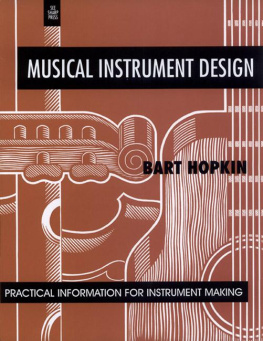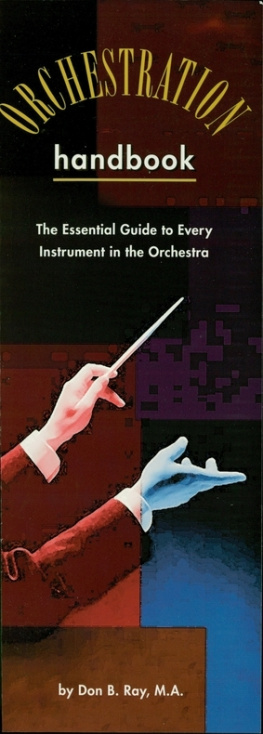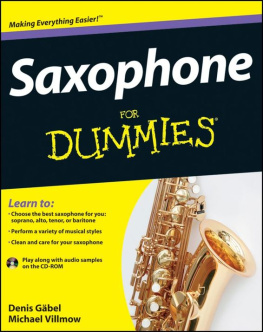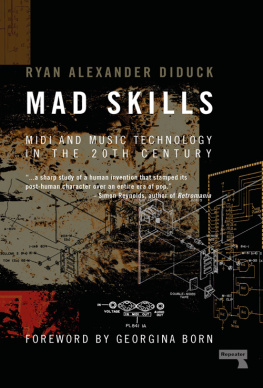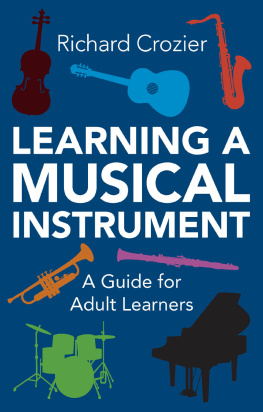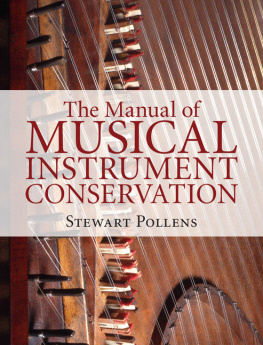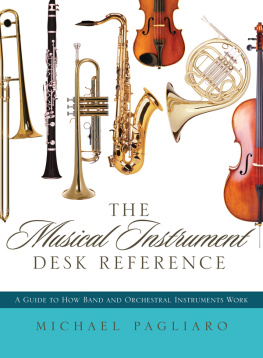Bart Hopkin - Musical Instrument Design: Practical Information for Instrument Making
Here you can read online Bart Hopkin - Musical Instrument Design: Practical Information for Instrument Making full text of the book (entire story) in english for free. Download pdf and epub, get meaning, cover and reviews about this ebook. year: 1995, publisher: See Sharp Press, genre: Home and family. Description of the work, (preface) as well as reviews are available. Best literature library LitArk.com created for fans of good reading and offers a wide selection of genres:
Romance novel
Science fiction
Adventure
Detective
Science
History
Home and family
Prose
Art
Politics
Computer
Non-fiction
Religion
Business
Children
Humor
Choose a favorite category and find really read worthwhile books. Enjoy immersion in the world of imagination, feel the emotions of the characters or learn something new for yourself, make an fascinating discovery.
- Book:Musical Instrument Design: Practical Information for Instrument Making
- Author:
- Publisher:See Sharp Press
- Genre:
- Year:1995
- Rating:3 / 5
- Favourites:Add to favourites
- Your mark:
- 60
- 1
- 2
- 3
- 4
- 5
Musical Instrument Design: Practical Information for Instrument Making: summary, description and annotation
We offer to read an annotation, description, summary or preface (depends on what the author of the book "Musical Instrument Design: Practical Information for Instrument Making" wrote himself). If you haven't found the necessary information about the book — write in the comments, we will try to find it.
Bart Hopkin: author's other books
Who wrote Musical Instrument Design: Practical Information for Instrument Making? Find out the surname, the name of the author of the book and a list of all author's works by series.
Musical Instrument Design: Practical Information for Instrument Making — read online for free the complete book (whole text) full work
Below is the text of the book, divided by pages. System saving the place of the last page read, allows you to conveniently read the book "Musical Instrument Design: Practical Information for Instrument Making" online for free, without having to search again every time where you left off. Put a bookmark, and you can go to the page where you finished reading at any time.
Font size:
Interval:
Bookmark:
Table of Contents

Copyright 1996 by Bart Hopkin.
All rights reserved.
For information contact See Sharp Press, P.O. Box 1731, Tucson, AZ 85702-1731 or contact us via our web site: www.seesharppress.com
Hopkin, Bart.
Musical Instrument Design / by Bart Hopkin; with an introduction by Jon Scoville. Tucson, AZ : See Sharp Press, 1996.
181 pp. ; music ; 28 cm
Includes bibliographical references (p. 177) and index (p. 179)
ISBN 1-884365-08-5 (pbk.)
1. Music Instruments Design and construction. 2. Music Instruments Theory. 3. Music Philosophy and esthetics. 4. Music Theory. I. Title.
784.1922
First printing June 1996
Second printing June 1998
Third printing August 2000
Fourth printing September 2003
Fifth printing February 2005
Sixth printing February 2007
Back cover instruments: Glass Marimba by Michael Meadows; Gourd Drums by Darrel DeVore; Five-Bell Bull Kelp Horn by Bart Hopkin. Photo of Glass Marimba by Serge Gubelman; photo of Gourd Drums by Bart Hopkin; photo of Bull Kelp Horn by Janet Hopkin.
Front cover design by Clifford Harper. Back cover design by Chaz Bufe. Interior design and illustrations by Bart Hopkin. Interior typeset in Times Roman, Futura, and Arial. Cover typeset in Avant Garde and Futura.
ACKNOWLEDGMENTS

Most of the ideas in this book are not my own. Many are common currency, having been part of musical instrument building practice for years and years. Others I have picked up in my extensive contacts with other instrument makers, and through familiarity with their instruments and writings. These makers are knowledgeable, skilled and inventive individuals and terribly generous too, every one of them. This book owes an incalculable debt to all who have shared then-ideas and experience with me over the years. By rights the list should be much longer, but here are a few of those people:
Francois Baschet, Minnie Black, Wes Brown, Glenn Branca, Warren Burt, John Chalmers, Cary Clements, John W. Coltman, Bill Colvig, David Courtney, Frank Crawford, Phil Dadson, Ivor Darreg, Hugh Davies, Darrell De Vore, David Doty, Jacques Dudon, William Eaton, Rick Elmore, Cris Forster, Ellen Fullman, Denny Genovese, Reed Ghazala, Frank Giorgini, Jonathan Glasier, Robin Goodfellow, Richard Graham, Donald Hall, Lou Harrison, Colin Hinz, Sarah Hopkins, Douglas Keefe, Buzz Kimball, Gary Knowlton, Skip La Plante, Rupert Lewis, Brian McLaren, Bonnie McNairn, Michael Meadows, Tom Nunn, Nazim Ozel, Paul Panhuysen, Bob Phillips, Tony Pizzo, Nadi Qamar, Hal Rammel, Susan Rawcliffe, Sharon Rowell, Sascha Reckert, Hans Reichel, Prent Rodgers, Rick Sanford, Charles Sawyer, Daniel Schmidt, Jon Scoville, Mark Shepard, TENTATIVELY, a CONVENIENCE, Trimpin, Sugar Belly Walker, Dennis Waring, Richard Waters, Erv Wilson, Jim Wilson, Peter Whitehead.
Equally essential to the making of this book have been the people who read and criticized the manuscript prior to publication. Donald Hall, David Kreimer, Skip La Plante, Michael Meadows, Jon Scoville, Stephen Golovnin and Dennis Waring reviewed and corrected the manuscript for practical, technical and scientific accuracy. Widiout the assurance of their expertise, not to mention their myriad ideas and suggestions, I could not have presented much of the material contained here. Kate Buckelew, Janet Hopkin, and especially Nan Hopkin, along with the others just mentioned, provided invaluable stylistic and editorial criticism. Chaz Bufe, my editor at See Sharp Press, gave it the final polish with just the right instinct for simplifying and clarifying the language. Without their guidance, this book would have been a far more awkward and less inviting thing to read.
To all these people, my heartfelt thanks and appreciation.
To my wife, Janet, and my son, Shane, who offered boundless support and patience during the long and arduous preparation of the manuscript, my love and thanks.
INTRODUCTION

by Jon Scoville
So ... you've opened this book, flipped through its pages, looked at its illustrations, tables, charts, and sidebars, and have seen that there's a universe of sound here for the making. And now you're sitting down with the intention of actually reading it. (In this computer-driven age, it's still the normal way our old flat-bed brains scan stuff into the corporeal PC.) But before you enter Bart Hopkin's Wonderful World of the Ways and Whys of Sound, allow yourself an imaginary journey:
Close your eyes, lean back, and imagine a group of musicians tuning up, then launching into a loud, glorious fanfare... with your choice of instruments, of course. Strings and brass and timpani? Sure. But how about instead a vast orchestra of saws and wobbleboards, mirlitons, rattles, marimbas, tongue drums, and tuning forks? Arising from it is a clangor and cacophony full of overtones and implications as busy as an urban street corner, but as bright with possibility as a sunrise on a glistening sandy beach. Those waves of sound arising in your imagination, be they made by traditional instruments or by something as improbable as a balloon-mounted bar gong, are all following predictable and logical laws of acoustics (at least in this corner of the galaxy I can't vouch for that parallel universe lurking just around the corner). This book that you hold in your hands (as you dream of new solar systems of sound) is really a guide to unfold those patterns and laws of sound, to explain some of the mysteries, and to give you the tools to create new ones.
There is an ancient imperative lodged in our DNA which asks us to make music. Our intuitive understanding of being alive on this blue planet is most poetically expressed in our songs and dances. In our instinct to organize sound and movement we fully express both the ambiguities and certainties of life. Making the instruments that make the music that makes the soundtracks to our lives is one of the ways that we reconnect ourselves with the world and with our ancient heritage. Thus we join that long tradition of (mostly) unknown instrument makers who gave birth to drums, violins, lutes, bamboo zithers, steel drums, gamelan, and the countless other instruments that produce our planet's songs and symphonies.
Yet the principles and procedures of instrument construction are often viewed as being as incomprehensible as those involved in building a car or a computer. The beauty of this book is that it gives you a Rosetta stone to understand the tools, resources, and formulas that will equip you to enter the world of instrument construction. The poetry of how your instruments will look, and, more importantly, what kind of music they will play, is left up to you. Dive in. The water is deep, but warm and inviting. The universe of sound is yours for the making.
PREFACE

This book is a guide for anyone interested in musical instrument making.
In the chapters that follow we'll survey the fundamentals of instrument design. In the process, we'll get to know the acoustic relationships that underlie familiar musical instruments, and a host of new and unusual instruments as well. My goal is that this book will help you gain an acoustical sense that will serve you well in the creation of all kinds of acoustic instruments, both traditional and innovative. This book will also fill a continuing role as a handy reference for practical information on instrument design and construction.
Next pageFont size:
Interval:
Bookmark:
Similar books «Musical Instrument Design: Practical Information for Instrument Making»
Look at similar books to Musical Instrument Design: Practical Information for Instrument Making. We have selected literature similar in name and meaning in the hope of providing readers with more options to find new, interesting, not yet read works.
Discussion, reviews of the book Musical Instrument Design: Practical Information for Instrument Making and just readers' own opinions. Leave your comments, write what you think about the work, its meaning or the main characters. Specify what exactly you liked and what you didn't like, and why you think so.

